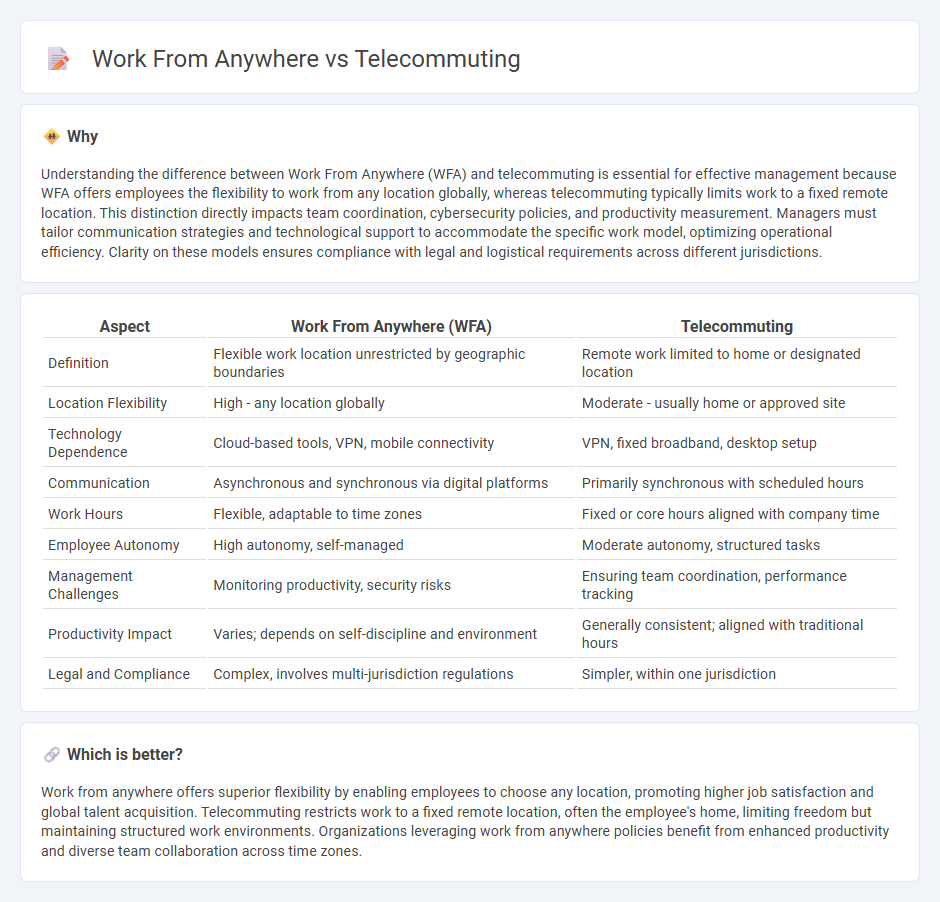
Work from anywhere enables employees to perform tasks from any location with internet access, providing enhanced flexibility and autonomy compared to traditional telecommuting, which typically involves remote work confined to a designated home office. Both management styles leverage digital communication tools to maintain productivity and team collaboration, yet work from anywhere supports a broader range of working environments and lifestyle choices. Explore how embracing these models can transform organizational efficiency and employee satisfaction.
Why it is important
Understanding the difference between Work From Anywhere (WFA) and telecommuting is essential for effective management because WFA offers employees the flexibility to work from any location globally, whereas telecommuting typically limits work to a fixed remote location. This distinction directly impacts team coordination, cybersecurity policies, and productivity measurement. Managers must tailor communication strategies and technological support to accommodate the specific work model, optimizing operational efficiency. Clarity on these models ensures compliance with legal and logistical requirements across different jurisdictions.
Comparison Table
| Aspect | Work From Anywhere (WFA) | Telecommuting |
|---|---|---|
| Definition | Flexible work location unrestricted by geographic boundaries | Remote work limited to home or designated location |
| Location Flexibility | High - any location globally | Moderate - usually home or approved site |
| Technology Dependence | Cloud-based tools, VPN, mobile connectivity | VPN, fixed broadband, desktop setup |
| Communication | Asynchronous and synchronous via digital platforms | Primarily synchronous with scheduled hours |
| Work Hours | Flexible, adaptable to time zones | Fixed or core hours aligned with company time |
| Employee Autonomy | High autonomy, self-managed | Moderate autonomy, structured tasks |
| Management Challenges | Monitoring productivity, security risks | Ensuring team coordination, performance tracking |
| Productivity Impact | Varies; depends on self-discipline and environment | Generally consistent; aligned with traditional hours |
| Legal and Compliance | Complex, involves multi-jurisdiction regulations | Simpler, within one jurisdiction |
Which is better?
Work from anywhere offers superior flexibility by enabling employees to choose any location, promoting higher job satisfaction and global talent acquisition. Telecommuting restricts work to a fixed remote location, often the employee's home, limiting freedom but maintaining structured work environments. Organizations leveraging work from anywhere policies benefit from enhanced productivity and diverse team collaboration across time zones.
Connection
Work from anywhere and telecommuting are interconnected concepts enabling employees to perform tasks outside traditional office settings using digital technologies. Both approaches leverage cloud computing, high-speed internet, and collaboration tools to facilitate remote productivity and communication. This flexibility enhances employee satisfaction, reduces commuting time, and supports business continuity in management strategies.
Key Terms
Remote Work Policies
Remote work policies distinguish telecommuting, which typically requires employees to work from a fixed home location, from work from anywhere models that allow flexibility in choosing any location globally. Companies adopting work from anywhere policies emphasize trust, cybersecurity measures, and clear communication protocols to support diverse time zones and cultural dynamics. Explore comprehensive strategies to tailor remote work policies that maximize productivity and employee satisfaction.
Location Flexibility
Telecommuting typically involves working remotely from a fixed location, such as a home office, whereas work from anywhere offers employees complete location flexibility, allowing them to perform tasks from any geographic spot globally. This broader flexibility can enhance work-life balance and access to diverse talent pools while requiring robust digital infrastructure and security measures. Explore how embracing work from anywhere policies can transform your organization's productivity and employee satisfaction.
Productivity Measurement
Telecommuting typically involves employees working remotely from a fixed location, such as home, while work from anywhere allows broader flexibility in choosing any workspace, impacting productivity measurement through variables like environment stability and connectivity. Productivity metrics in telecommuting often rely on time tracking and task completion, whereas work from anywhere demands adaptive measurement models accounting for diverse locations and varying conditions. Explore effective productivity strategies tailored to each remote work model to optimize performance outcomes.
Source and External Links
What Is Telecommuting in Today's Work Environment? - Telecommuting is a simple concept where employees connect with their company's computer network using a device and internet from a remote location.
What is telecommuting? - Telecommuting allows employees to complete work assignments outside the traditional workplace using telecommunications tools, available in full-time, part-time, and temporary arrangements.
Top Benefits of Telecommuting That Prove It's Here To Stay - Telecommuting offers benefits such as flexible scheduling, better work-life balance, and reduced commuting time, which enhance employee happiness and productivity.
 dowidth.com
dowidth.com